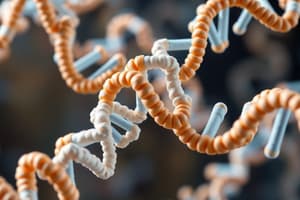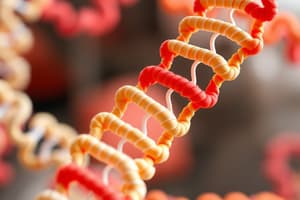Podcast
Questions and Answers
Which of the following describes the relationship between a codon and an amino acid?
Which of the following describes the relationship between a codon and an amino acid?
- One codon can code for multiple amino acids.
- A codon and an amino acid have a one-to-one correspondence.
- Codons and amino acids are independent of each other.
- Multiple codons can code for the same amino acid. (correct)
What is the primary function of the mRNA during translation?
What is the primary function of the mRNA during translation?
- To carry amino acids to the ribosome.
- To regulate gene expression.
- To catalyze the formation of peptide bonds.
- To provide the template for protein synthesis. (correct)
Which of the following is NOT a characteristic of the genetic code?
Which of the following is NOT a characteristic of the genetic code?
- It is triplet, meaning each codon consists of three nucleotides.
- It is overlapping, meaning codons can share nucleotides. (correct)
- It is unambiguous, meaning each codon codes for only one amino acid.
- It is universal, meaning it is the same in all organisms.
Which type of DNA mutation would lead to a frameshift mutation, potentially resulting in a completely different protein sequence?
Which type of DNA mutation would lead to a frameshift mutation, potentially resulting in a completely different protein sequence?
Which of the following best describes the role of tRNA in protein synthesis?
Which of the following best describes the role of tRNA in protein synthesis?
What is the significance of the 5' nontranslated leading sequence in mRNA?
What is the significance of the 5' nontranslated leading sequence in mRNA?
Which of the following statements accurately describes the role of aminoacyl-tRNA synthetase in protein synthesis?
Which of the following statements accurately describes the role of aminoacyl-tRNA synthetase in protein synthesis?
What structural difference between prokaryotic and eukaryotic ribosomes contributes to their distinct sensitivity to certain antibiotics?
What structural difference between prokaryotic and eukaryotic ribosomes contributes to their distinct sensitivity to certain antibiotics?
How does the activation of tRNA by aminoacyl-tRNA synthetase contribute to the accuracy of protein synthesis?
How does the activation of tRNA by aminoacyl-tRNA synthetase contribute to the accuracy of protein synthesis?
Which of the following processes directly involves the formation of peptide bonds?
Which of the following processes directly involves the formation of peptide bonds?
Which statement is TRUE about the ribosome?
Which statement is TRUE about the ribosome?
What is NOT a requirement for protein synthesis?
What is NOT a requirement for protein synthesis?
What is the function of tRNA in protein synthesis?
What is the function of tRNA in protein synthesis?
What is the correct order of events in protein synthesis?
What is the correct order of events in protein synthesis?
How many amino acids are needed to synthesize a specific protein?
How many amino acids are needed to synthesize a specific protein?
What is the role of the Shine-Dalgarno sequence in prokaryotic translation initiation?
What is the role of the Shine-Dalgarno sequence in prokaryotic translation initiation?
What is the role of elongation factors in translation elongation?
What is the role of elongation factors in translation elongation?
What is the key difference between the initiator tRNA in prokaryotes and eukaryotes?
What is the key difference between the initiator tRNA in prokaryotes and eukaryotes?
What are the key components required for translation initiation?
What are the key components required for translation initiation?
What happens during the A site binding of aminoacyl-tRNA in translation elongation?
What happens during the A site binding of aminoacyl-tRNA in translation elongation?
Flashcards
What is translation?
What is translation?
The synthesis of protein using mRNA as a template. It translates the nucleotide sequence of mRNA into the amino acid sequence of a protein according to the genetic code.
What is a codon?
What is a codon?
A three-nucleotide sequence on mRNA that dictates the type and position of an amino acid on a protein.
What are stop codons?
What are stop codons?
These are non-coding codons that signal the end of protein synthesis.
What is degeneracy in the genetic code?
What is degeneracy in the genetic code?
Signup and view all the flashcards
What is a mutation?
What is a mutation?
Signup and view all the flashcards
E site
E site
Signup and view all the flashcards
A site
A site
Signup and view all the flashcards
P site
P site
Signup and view all the flashcards
40S subunit
40S subunit
Signup and view all the flashcards
60S subunit
60S subunit
Signup and view all the flashcards
Translation
Translation
Signup and view all the flashcards
tRNA
tRNA
Signup and view all the flashcards
Anticodon
Anticodon
Signup and view all the flashcards
Ribosome
Ribosome
Signup and view all the flashcards
Aminoacyl-tRNA synthetase
Aminoacyl-tRNA synthetase
Signup and view all the flashcards
Codon
Codon
Signup and view all the flashcards
Transfer RNA (tRNA)
Transfer RNA (tRNA)
Signup and view all the flashcards
Initiation Codon
Initiation Codon
Signup and view all the flashcards
Initiation (Protein Synthesis)
Initiation (Protein Synthesis)
Signup and view all the flashcards
Study Notes
Protein Synthesis (Translation)
- Protein synthesis, also known as translation, uses mRNA as a template to create proteins.
- Translation involves converting the nucleotide sequence of mRNA into the amino acid sequence of a protein, following the genetic code.
- The genetic code is a "dictionary" that specifies the correspondence between a sequence of nucleotide bases and a sequence of amino acids.
- Each "word" in the code consists of three nucleotides, called codons.
- Codons specify the type and position of amino acids in the protein.
- There are 64 possible codons, which code for 20 amino acids.
- AUG is a start codon and codes for methionine in eukaryotes and N-formylated methionine in prokaryotes.
- UAA, UAG, and UGA are stop codons.
- The genetic code is degenerate, meaning more than one codon can code for the same amino acid.
- The wobble hypothesis explains the degeneracy of the genetic code. Base pairing at the third position of a codon is not strict, allows for flexibility in the tRNA-mRNA interaction.
- Mutations are permanent changes in DNA sequence that lead to new hereditary variations and create a mutant gene.
- Mutations can cause different types of genetic diseases.
- Point mutations involve substitution of one base pair by another.
- Transition mutations involve a purine to purine or pyrimidine to pyrimidine substitution.
- Transversion mutations involve a purine to pyrimidine or pyrimidine to purine substitution.
- Silent mutations occur when a single nucleotide change results in the same amino acid being incorporated.
- Missense mutations result in a change in the amino acid sequence and cause changes in the protein function
- Nonsense mutations cause premature termination of protein chain due to a codon alteration.
- Frame-shift mutations result from insertion or deletion of bases, changing the reading frame and causing significant changes in the resulting protein.
- The synthesis requires components including ribosomes, mRNA, tRNA, amino acids, aminoacyl-tRNA synthetase, and energy sources (ATP and GTP).
- Ribosomes are complex structures composed of protein and rRNA, responsible for protein synthesis.
- tRNA carries amino acids to the ribosomes, pairing with the mRNA codons.
- Aminoacyl-tRNA synthetase attaches the correct amino acid to the tRNA, requiring ATP.
- The process of translation occurs in three stages: initiation, elongation, and termination.
Objectives of Protein Synthesis
- Recognition of the genetic code, how they specify the order of amino acids during protein synthesis.
- Identification of genetic code characters.
- Comparison between different types of DNA mutation and the resulting genetic diseases.
- Identification of requirements of protein synthesis including ribosomes, mRNA, amino acids, tRNA, aminoacyl-tRNA synthetase enzymes.
- Steps of protein synthesis (Translation): Activation, Initiation, Elongation, Termination.
- Examples of inhibitors of protein synthesis.
- Recognition of post-translational processing of proteins.
Steps in Protein Synthesis (Translation)
- Activation: Amino acids are activated by attaching to tRNA, using aminoacyl-tRNA synthetases.
- Initiation: mRNA, first tRNA with methionine, and the small ribosomal subunit assemble with initiation factors.
- Elongation: Ribosome moves along the mRNA, adding amino acids to the growing polypeptide chain.
- Termination: A stop codon is reached, polypeptide chain release, and ribosome subunits dissociate.
- Folding and Post-translational Processing: Newly synthesized proteins fold into their 3-D functional conformations, and undergo modifications.
Inhibitors of Protein Synthesis
- Streptomycin, Tetracycline, Chloramphenicol, Erythromycin, clindamycin, Puromycin, Ricin, Diphtheria toxin are examples of protein synthesis inhibitors.
- These agents disrupt various steps in translation, such as initiation complex formation, translocation, aminoacyl-tRNA binding, or peptidyl transferase activity.
Properties of the Genetic Code
- Unambiguous: Each codon specifies only one amino acid.
- Degenerate: Multiple codons can code for the same amino acid.
- Universal: The same codons specify the same amino acids in all organisms.
- Non-overlapping: Codons are read one after another without overlapping.
- Non-punctuated: No punctuation between codons.
Mutations
- Mutations can be point mutations (e.g., silent, missense, nonsense mutations) or frame-shift mutations (insertion or deletion).
- Mutations change the genetic code causing abnormal proteins, diseases, and in some cases, evolutionary changes.
Post-Translational Processing
- Modifications of newly synthesized proteins after translation.
- Examples: Trimming (removal of parts of the polypeptide chain), covalent modifications (phosphorylation, glycosylation, acetylation, hydroxylation, carboxylation), folding, and quaternary structure assembly.
Requirements of Protein Synthesis
- Ribosomes (protein synthesizing machinery)
- mRNA (carries genetic code)
- Amino acids (building blocks)
- tRNA (carries amino acids to ribosomes)
- ATP (energy source)
- GTP (energy source)
- Aminoacyl-tRNA synthetases (link amino acids to tRNA)
- Protein factors (facilitate ribosome-mRNA and tRNA interactions)
Studying That Suits You
Use AI to generate personalized quizzes and flashcards to suit your learning preferences.
Related Documents
Description
Test your knowledge on the translation process in molecular biology. This quiz covers key concepts like codons, mRNA function, tRNA roles, and mutations. Assess your understanding of protein synthesis and its mechanisms.




